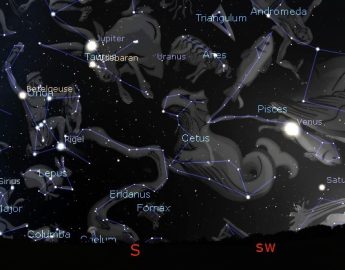This Week’s Sky at a Glance, 2025 Feb 8 – Feb 25
This Week’s Sky at a Glance, 2025 Feb 8 – Feb 25
We are more than halfway to spring and, as Lord Tennyson wrote in his poem Locksley Hall, “in the spring a young man’s fancy turns lightly to thoughts of love.” With Valentine’s Day this week the goddess of love is sharing the sky with her father. Venus is the Roman counterpart of Aphrodite, the Greek goddess of love. She was the daughter of Zeus (Jupiter to the Romans) and Dione, which is the name of one of Saturn’s moons. After sunset the planet Venus is high in the west in the constellation Pisces, much brighter but lower than her father in Taurus to the south.
Venus is not the only love object in the night sky. In 1898 astronomers discovered the first asteroid that was known to come closer to the Sun than Mars, one that nearly reaches Earth’s orbit. This 33 x 11 kilometre rock was named Eros for the son of Aphrodite, and to the Romans he was known as Cupid. In mythology the Olympians were frightened at the seashore by Typhon, the most horrible monster of the rival Titans. Venus and Cupid knew they would be safe in the water, but before changing into fish they tied their feet together so they would not lose each other in the sea. This act is immortalized as the constellation Pisces, depicting two fish bound together at the tails. Another astronomical valentine, and a favourite of astrophotographers, is the Heart Nebula in Cassiopeia the Queen.
This Week in the Solar System
Saturday’s sunrise in Moncton is at 7:32 and sunset will occur at 5:35, giving 10 hours, 3 minutes of daylight (7:35 and 5:42 in Saint John). Next Saturday the Sun will rise at 7:21 and set at 5:45, giving 10 hours, 24 minutes of daylight (7:25 and 5:52 in Saint John).
The Moon is full on Wednesday, the Mi’Kmaq Snow Blinding Moon. On Valentine’s Day Venus is at its greatest illuminated extent, glowing at its brightest. As Venus nears us in the evening sky it appears larger in a telescope but the phase decreases from near full to slim crescent. At some point, which occurs about five weeks before inferior conjunction, we see the maximum sunlit area. The same effect occurs in the morning sky five weeks after inferior conjunction as the planet recedes and the phases reverse. Saturn appears increasingly lower in the sky below Venus as it heads toward solar conjunction in a month. Jupiter is at its highest around 7:30 pm, followed by Mars two and a half hours later. Mercury is at superior conjunction this weekend, moving toward a favourable evening apparition in a couple of weeks.
Tune in to the Sunday Night Astronomy Show at 8 pm on the YouTube channel and Facebook page of Astronomy by the Bay.

